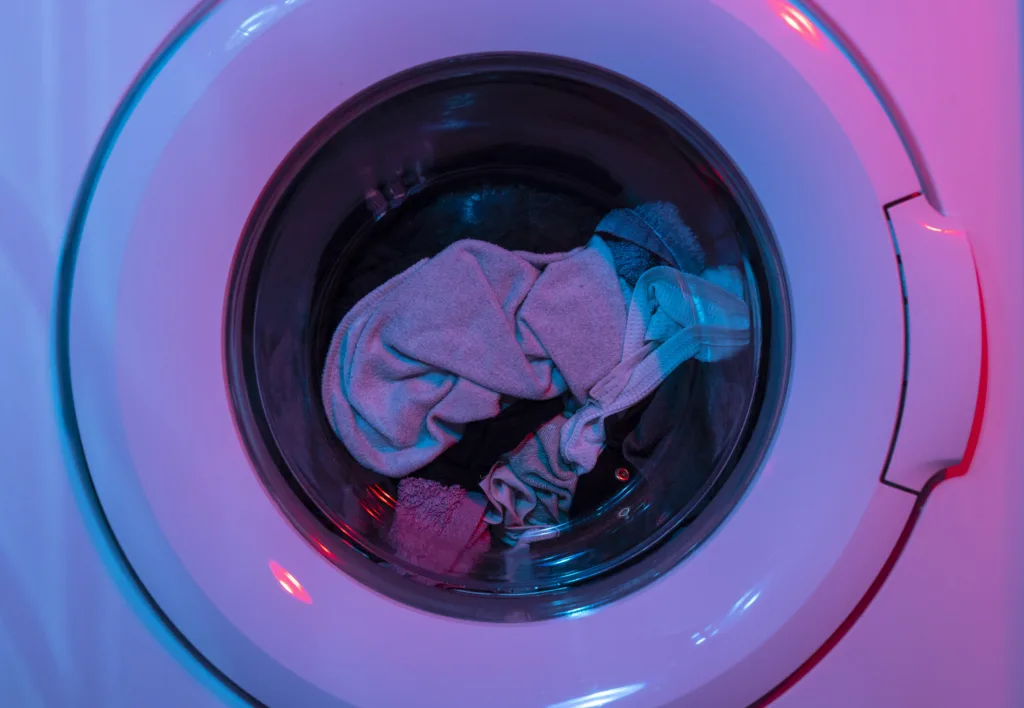When it comes to doing laundry, it’s essential to know the different washing cycles available on your machine. The delicate cycle and gentle cycle are two settings that are often used interchangeably, but are they the same? Let’s take a closer look.
The delicate cycle is designed for washing clothes that require extra care. These items may include silk, lace, or other lightweight fabrics that can easily snag or tear. The delicate cycle is characterized by a slower spin speed and gentler agitation, which helps to prevent damage to delicate items.
On the other hand, the gentle cycle is also designed for delicate items, but it may be slightly more robust than the delicate cycle. The gentle cycle is ideal for washing clothes that require a little more cleaning power than the delicate cycle can provide. For example, if you have a delicate blouse that is also stained, you might want to use the gentle cycle instead of the delicate cycle.
So, is delicate the same as the gentle cycle? In most cases, yes. Many washing machines use these terms interchangeably, and both cycles are designed to be gentle on delicate fabrics. However, it’s alays a good idea to check your machine’s user manual to see what specific settings are available.
When using either the delicate or gentle cycle, there are a few things to keep in mind. First, always check the care label on your clothes to ensure that they are safe to be washed in the machine. Some delicate items may require hand-washing or dry-cleaning, so it’s essential to follow the manufacturer’s instructions.
Additionally, use a gentle laundry detergent that is specifically designed for delicate fabrics. These detergents are formulated to be gentle on fabrics while still providing effective cleaning power. Avoid using fabric softeners or bleach, which can damage delicate fabrics.
The delicate cycle and gentle cycle are both designed to be gentle on delicate fabrics. While there may be slight differences between the two settings, they are often used interchangeably. When using either cycle, always check the care label on your clothes and use a gentle laundry detergent for best results.
The Difference Between Delicate and Gentle on a Washing Machine
When it comes to washing machines, the terms “delicate” and “gentle” are often used interchangeably. Both options are designed to handle more delicate fabrics that require a softer touch than regular laundry cycles. While the wording may differ from one machine to another, the general function of both settings is the same: to use colder water temperatures and low agitation or tumbling speeds to prevent damage to clothes.
The delicate cycle is typically used for fabrics that are more fragile or prone to shrinking, such as lace, silk, or wool. It’s also a good option for washing bras, underwear, and other delicates that may require special care. On some washing machines, the delicate cycle may be labeled as “hand wash” or “wool” to indicate its intended use.
The gentle cycle, on the other hand, is more versatile and can be used for a wider range of fabrics. It’s still designed to be gentler than regular laundry cycles, but it may use slightly warmer water temperatures and more agitation or tumbling than the delicate cycle. This makes it a good option for washing lightly soiled clothes, as well as items that are not necessarily delicate but culd benefit from a more gentle wash.
While the terms “delicate” and “gentle” may be used interchangeably on washing machines, both settings are designed to provide a softer wash for more fragile fabrics. The delicate cycle is typically used for the most delicate items, while the gentle cycle is a more versatile option for a wider range of fabrics.

What Is the Equivalent of a Gentle Cycle?
The gentle cycle is the most delicate setting on washing machines that is specifically designed for washing delicate fabrics wthout causing any damage. However, some washing machines may have different names for the gentle cycle such as delicate, hand wash, or wool. The equivalent setting to the gentle cycle depends on the specific settings of each washing machine. It is important to check the user manual or the control panel of your washer to determine the equivalent setting to the gentle cycle. When washing delicate fabrics, it is recommended to use cold or warm water and low spin speed or no spin to prevent any damage to the material. Some washing machines also have a soak or pre-wash cycle that can be used to remove stains from delicate fabrics. It is important to always check the care label of your clothing items to ensure that they are suitable for washing in the washing machine and to follow the manufacturer’s instructions for best results.
The Benefits of Using the Delicate Cycle for Laundry
The delicate cycle is specifically designed to wash delicate items like silk, wool, lingerie, and silk without causing damage. However, it is not recommended to use the delicate cycle for everything because some items may require a more robust wash cycle.
For example, using the delicate cycle for heavily soiled clothes may not provide a thorough cleaning. Similarly, using the delicate cycle for items with embellishments, such as beads, sequins, or embroidery, may cause damage to the delicate detailing.
On the oter hand, the delicate cycle is perfect for washing delicate fabrics that require gentle care. It uses a slower spin speed, less agitation, and lower water temperature, which reduces the risk of damage to the fabric.
Therefore, it is advisable to use the delicate cycle for items that specifically require it, such as silk, wool, lingerie, and other delicate fabrics. For other items, it is recommended to use a more appropriate cycle, such as the normal or heavy-duty cycle, depending on the level of soiling and the fabric type.
While the delicate cycle can be useful for washing delicate items, it is not suitable for everything. It is essential to read the care label on each item of clothing and follow the manufacturer’s instructions to ensure the best cleaning results and to prevent damage to your garments.
Understanding the Meaning of ‘Delicate’ in Washing Machines
When it comes to washing clothes in a washing machine, there are a variety of settings to choose from depending on the type of fabric you’re washing. One of the most commonly used settings is the “delicate” setting. But what exactly does “delicate” mean in the context of washing machines?
The delicate setting on a washing machine is specifically designed for delicate fabrics that require a gentler wash. Fabrics such as silk, lace, and certain types of wool are prone to damage if they are washed too vigorously. The delicate setting helps to protect these fabrics by using a lower agitation wash and a lower speed spin.
Here are some of the key features of a delicate wash:
– Low agitation: Delicate fabrics require a gentler wash, so the delicate setting on a washing machine uses a lower agitation wash. This means that the washing machine drum will rotate at a slower speed, whch helps to prevent damage to delicate fabrics.
– Low-speed spin: The delicate setting also uses a lower speed spin. This means that the washing machine drum will rotate at a slower speed during the spin cycle, which helps to prevent delicate fabrics from becoming tangled or stretched out.
– Shorter wash cycle: The delicate setting on a washing machine typically uses a shorter wash cycle than other settings. This helps to minimize the amount of time that delicate fabrics are exposed to water and detergent, which can help to prevent damage.
The delicate setting on a washing machine is ideal for fabrics that require a gentler wash. If you’re washing delicate fabrics such as silk, lace, or certain types of wool, it’s important to use the delicate setting to help protect them from damage.

Conclusion
The gentle cycle or delicate wash is an essential setting on washing machines that allws individuals to clean their delicate clothing items without causing any damage. This cycle is characterized by low agitation, colder water temperatures, and low spin speeds, making it ideal for materials like silk, wool, and lingerie that require gentle care. It is crucial to check the specific settings on your washer and the clothing item’s care label to determine the ideal wash cycle. While the delicate cycle may take longer, it is worth it to preserve the quality and lifespan of your delicate garments. the gentle cycle is an excellent option for those who want to keep their delicate clothing items in top condition.
